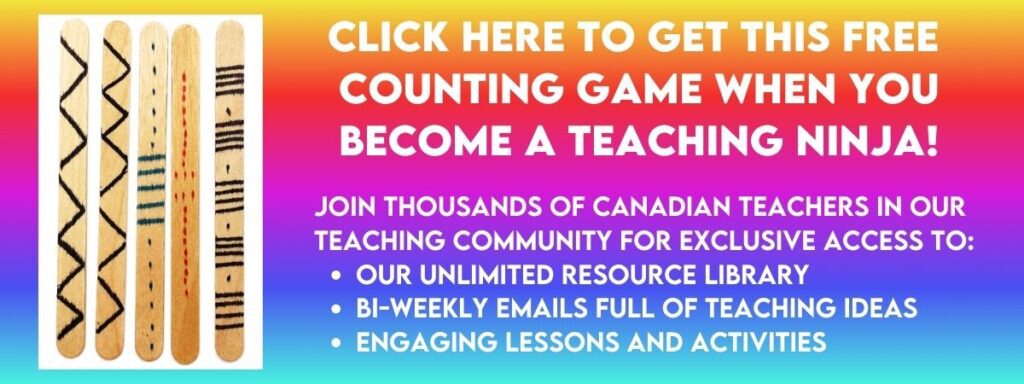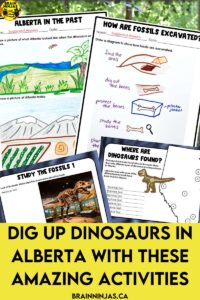
Most children go through a phase fascinated by dinosaurs. It only fits that living in Alberta means digging up dinosaurs and learning about fossil fuels. While learning about the specific dinosaurs is not in school curriculums, the result of their extinction is part of our lives today. Come learn about some of the ways we bring dinosaurs into our elementary science lessons. We’ve updated our lessons for the new Alberta science curriculum, but they work for any teacher wanted to roar through science (see what we did there?).
Why Dinosaurs?
We start our lessons by discussing what students already know about dinosaurs or fossil fuels. Students often know the different names of dinosaurs whether from watching Jurassic Park or reading their names in books. It’s amazing how many students who can read basic information can still identify the names of many dinosaurs.
Millions of years ago, the place that is now Alberta was a sea. Freshwater running on the surface from storms, creeks and rivers pushed the remains into lakes or bodies of water. They were preserved due to less oxygen under the water. These large pockets slowly decomposed and created the large deposits of oil and natural gas that are now part of Alberta’s economy. Oil and natural gas are processed into energy. This energy is used to heat homes and power vehicles. Unfortunately, using fossil fuels creates greenhouse gas which is changing the climate. While the Earth has natural processes to continue thriving, humans may not be able to survive these changes.
Dinosaur remains that did not break down into fossil fuels have been found as skeletons around the world. When Indigenous People found bones, they assumed they were from large animals, but did not have the technology to compare it with other bones around the world. Scientists thought bones found in England in 1676 belonged to a human giant or some sort of giant lizard. More recently, people have discovered that many people in Africa had described bones and fossils as early as 1175.
Today’s fascination with dinosaurs includes their use in energy products. Learn more in our post Make the Best of Your Natural Resources Lessons.
Who Studies Dinosaurs?
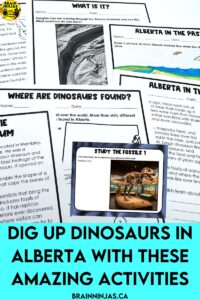
Can you imagine a world where we don’t know about dinosaurs or their bones? Paleontologists locate, preserve, study and compare fossils. Using a single bone, these scientists are able to determine what they ate, looked like and where they lived.
Aside from dinosaurs, paleontologists study ancient life. They learn about the landscape, other creatures, vegetation and even the climate by studying core samples and remains found deep in the earth. This helps us better understand how these ancient creatures lived and what may have caused them to die and become extinct.
Where to Find Dinosaurs
Joseph Burr Tyrrell was working as a geologist for the Geological Survey of Canada. He discovered the first dinosaur bones in Alberta on August 12, 1884. The Royal Tyrell Museum is in Drumheller, Alberta. Drumheller is also home to the world’s largest dinosaur statue. People can climb all the way up to the top of the dinosaur inside and stand looking out of its mouth. The museum opened in 1985.
Near Drumheller is Alberta’s Dinosaur Provincial Park. This park is a UNESCO World Heritage Site because of its dinosaur remains and badlands landscape. Scientists regularly study the dinosaur remains in the area. The park became part of Alberta’s Provincial Park system in 1955.
Another place to learn about dinosaurs is at the Phillip J Currie Dinosaur Museum in Wembley, Alberta. This museum is named for paleontologist Dr. Phillip J Currie. He helped create the Royal Tyrell Museum and was a specialist in dinosaurs that lived in Alberta. He found evidence that dinosaurs and birds are connected.
If you teach in Alberta, learning about the dinosaurs and paleontologists in Alberta is part of the new science curriculum. You can find Alberta’s Dinosaurs in our TpT Store ($USD) or our BN Shop ($CAN). The resources include complete lesson plans with options for differentiation, student pages, a digital version and engaging activities that our students have loved.
The Bone Wars
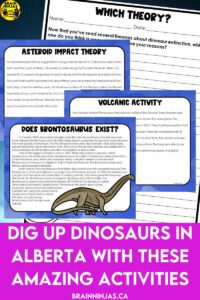
A frenzy of searching for fossils started in the 1800s. It is known as The Great Dinosaur Rush. From 1877 to 1892, paleontologists competed to see who could find the most fossils. Two American paleontologists, Edward Drinker Cope (of the Academy of Natural Sciences of Philadelphia) and Othniel Charles Marsh (of the Peabody Museum of Natural History at Yale) dominated the rush. They used their money to fund expeditions and sabotage competitors. Many fossils were lost, damaged or misidentified during the Bone Wars. In fact, the misnamed Brontosaurus comes from this competition.
We have students learn about the naming of Brontosaurus in our Dinosaur Extinction Resource written for Grade 6. Students learn about misinformation while clarifying the name of this common species. Find Dinosaur Extinction in our TpT Store ($USD) or our BN Shop ($CAN). The resource includes a complete lesson plan with options for differentiation, student pages, and a digital version. Our favourite activity is a critical thinking activity where students have to decide if Brontosaurus has ever existed.
How Did Dinosaurs Become Extinct?
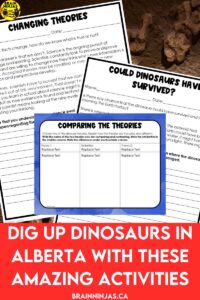
There are many different theories about how the dinosaurs came to be extinct. One thing that is clear is that the dinosaurs died out over time. It was not one event and every single one died at the exact same moment. While researching the different theories to write our resources, we were amazed at the number of theories and how they’ve changed since our own childhoods.
During our research, one thing that became clear is that many people do not understand the difference between a theory and supporting evidence. Anyone can have a theory. Having evidence to support or disprove the theory is where many people don’t understand how to decide which information is accurate and which is not.
Paradigm Shifts
In general, scientific facts are confirmed by multiple sources. For a scientific theory to become a fact, it must be researched and reviewed. New information or new technology makes more learning possible. This is a paradigm shift. Unfortunately, the shifts in thinking can take a very long time.
Here is a simple example that shows a paradigm shift. Scientists once believed that illnesses passed through bad air. Eventually, scientists found germs using microscopes. Scientists realized that basic hygiene like washing hands could prevent illness. The germ theory led to much more effective treatments and containment of disease.
The problem lies when people think that paradigm shifts mean the previous information was unreliable and use it as the reason that all science is unreliable. That’s not accurate. Science is about constantly proving and disproving theories. The purpose of science is to continually learn more.
Theories of Extinction
The same is true for how the dinosaurs died. Theories have changed over time. Scientists continually learn new information. It is likely that that theories will continue to change. Evidence has disproved some theories. There are still some theories without enough evidence to prove or disprove.
Our Dinosaur Extinction resource asks students to use critical thinking to discuss the different theories. Students rate how likely the theory could be accurate. Find Dinosaur Extinction in our TpT Store ($USD) or our BN Shop ($CAN). The resource includes a complete lesson plan with options for differentiation, student pages, and a digital version. We have intentionally included lots of different theories so students can practice critical thinking.
Did You Know?
What would happen if you were out for a walk and came across a fossil? Could you take it home? It’s not quite that simple. Depending on where it is, how deep it is, and what it is, you may get to become the custodian. But, the province of Alberta automatically owns it. It is illegal to dig up fossils without the proper permits. Alberta’s Historical Resources Act means you can receive a fine of up to $50 000 or even go to prison. This link has more information.
Create a Dinosaur
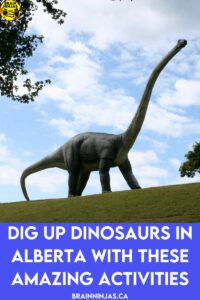
We found this video to make an origami Triceratops. There are lots of other videos online to make other species. This page has instructions for drawing a variety of species.
You can also create your own fossil dig. You can use these instructions to make your own, or you can simply bury some clean bones in a bucket of sand. The resource for Alberta’s dinosaurs goes through the process in more detail and teaches students all the steps paleontologists complete. You can find Alberta’s Dinosaurs in our TpT Store ($USD) or our BN Shop ($CAN).
Your students could also play this traditional game using actual bones (instead of the craft sticks mentioned in the instructions). You can find the Bone Game in our Resource Library or we can send you the instructions when you science up for our email list.
Do you teach science?
If you teach science in Alberta, we have a list of all the resources we provide on this page.
If you teach in Canada, these blog posts might be helpful:
- How to Shock Your Students With Engaging Electricity Lessons
- 10 Engaging Weather Lessons All in One Place
- How to Grow a Healthy Classroom with Plants
- How to Escalate Your Chemistry Experiments
- 15 Simple Machines Activities that Will Hook Your Students
- Astronomy Lessons That Are Out of This World
- How to Teach Coding Without Knowing How to Code
What is your favourite part about teaching lessons involving fossils? We want to know. Tell us in the comments below.

